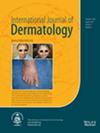Prognosis of chronic spontaneous urticaria with an inadequate response to omalizumab
Abstract
Background
Chronic spontaneous urticaria (CSU) exhibits notable responsiveness to omalizumab (OMA). The prognosis and subsequent therapeutic strategies warrant comprehensive exploration in cases exhibiting inadequate responses to OMA.
Methods
We conducted a multicenter retrospective analysis to investigate the 12-month prognosis of patients inadequately responding to three injections of OMA. The endpoints encompassed identifying predictive factors for a favorable prognosis and assessing interventions related to an ameliorated prognostic outlook.
Results
The study involved 48 patients who met the inclusion criteria. After three OMA administrations, therapeutic interventions included the continuation of OMA in 34 patients, systemic corticosteroids in seven patients, and immunosuppressants in 12 patients. After 12 months, 28 of the 48 patients exhibited a good prognosis, whereas the remaining 20 displayed a less favorable prognosis. Good prognostic determinants encompassed the duration of CSU within 51 weeks, the presence of angioedema, IgE levels ≤100 IU/mL pre-OMA, blood eosinophil counts ≥100/mm3 post-OMA, and urticaria control test (UCT) scores ≥5 pre-OMA and ≥6 post-OMA. Following the third OMA injection, the implementation of immunosuppressants presented an association with a good prognosis, while the employment of systemic corticosteroids correlated with an unfavorable prognosis.
Conclusions
More than half of patients inadequately responding to OMA achieved a good prognosis 12 months later. Several clinical variables appear to be predictive of prognosis, and certain therapeutic agents can be associated with prognostic outcomes.


 求助内容:
求助内容: 应助结果提醒方式:
应助结果提醒方式:


